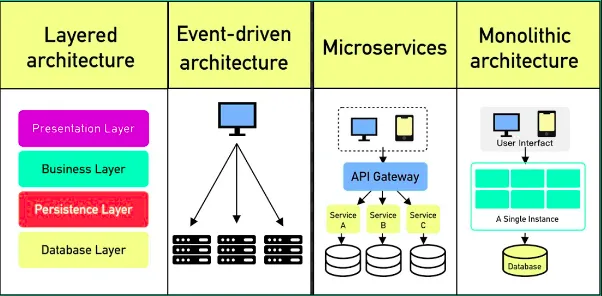Published
-
Monolithic Architecture Pattern

In software development, a monolithic architecture model is one where a single codebase is used to perform multiple functions in an application.
Monolithic Architecture
- A single, unified application containing all functionality.
- Everything packaged together in one deployable unit
- All components run in the same process.
- Uses one technology stack throughout the application.

Example
In a monolithic e-commerce application, all features like displaying products, processing orders, and accessing product data are part of the same codebase.
// All functionality in one application
public class EcommerceApp {
// User Interface Components
class UserInterface {
void displayProducts() { /* ... */ }
void showCart() { /* ... */ }
}
// Business Logic
class OrderService {
void placeOrder() { /* ... */ }
void processPayment() { /* ... */ }
}
// Data Access
class ProductRepository {
void saveProduct() { /* ... */ }
void getProduct() { /* ... */ }
}
}
Advantages
- Simple to develop: Easier for smaller teams to manage and understand.
- Easy to deploy (single unit): Since it’s a single unit, you only need to deploy once.
- End-to-End testing: Testing the whole application is straightforward.
- Scales Horizontally: You can scale the entire app by cloning and running on multiple servers.
- Less complexity: With no distributed components, networking and monitoring are simpler.
Disadvantages
- Size grows over time
- Hard to maintain as complexity increases
- Long build/deploy times
- Must redeploy entire app for small changes
- Technology stack is fixed : Switching technologies is challenging since everything uses the same stack.
- Can be harder to understand a large, tightly-coupled codebase for new developers
Best Use Cases
- Small to Medium applications: Great for apps that don’t need complex scalability or heavy integrations.
- Startups/MVPs: Ideal for building minimum viable products quickly and efficiently.
- Simple business domains: Works well for straightforward business logic.
- Small development teams: Easier for small teams to handle without over-complicating the architecture.
- Minimal integration needs: Best for applications that don’t rely heavily on external services or systems.
Best Practices for Monolithic Architecture
- Maintain Clear Module Boundaries: Separate concerns using well-defined modules.
- Layered Architecture: Organize your code into layers (e.g., presentation, business logic, and data).
- Caching: Implement caching to reduce load and improve performance.
- Coding Standards: Follow consistent coding guidelines across the application.
- Regular Refactoring: Clean up and optimize your code as it grows.
- Proper Logging and Monitoring: Keep track of application performance and issues with good logging practices.
Real-World Example Structure
my-monolithic-app/
├── src/
│ ├── presentation/
│ │ ├── controllers/
│ │ └── views/
│ ├── business/
│ │ ├── services/
│ │ └── models/
│ └── data/
│ ├── repositories/
│ └── entities/
├── resources/
├── tests/
└── config/
This structure separates the presentation, business, and data layers, ensuring some organization within the single codebase.
Some of Software Architecture Patterns
